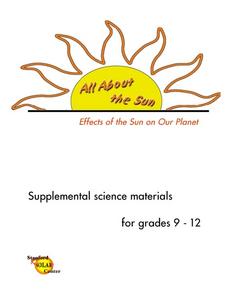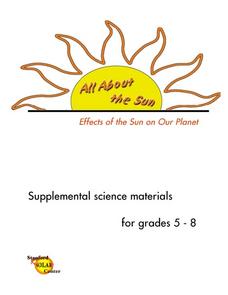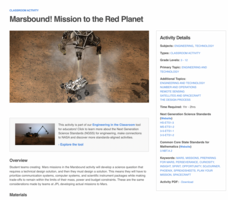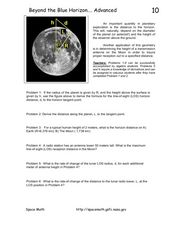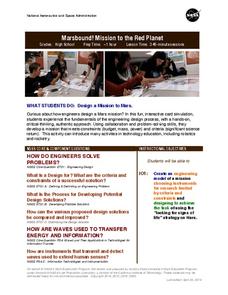Curated OER
History of Saturn Discoveries
Students interpret how scientists have explored Saturn. In this NASA based astronomy lesson, students create a timeline depicting the study of Saturn from 1610 until 2010. Each student will write a letter to Galileo discussing how the...
Curated OER
Effects of the Sun on Our Planet (Grades 9-12)
Students examine the Earth's magnetosphere and observe the effects of the sun's energy on it. They discover the difference between true north and magnetic north. They also explore how solar cells convert solar energy to electricity.
Curated OER
Space: Stars and Planets
Students observe and report that the moon can be seen sometimes at night and sometimes during the day. They describe how changes to a model can help predict how the real thing can be altered. Students explain the essential fact of the...
Curated OER
Effects of the Sun on Our Planet
Students examine the effect of different types of light on the Earth. They discover the role of evaporation and the effects of the sun on the magnetosphere. They also observe different solar phenomena.
Curated OER
The Planets Moon
Students explore the theories of the creation of the universe and examine the properties of celestial bodies. They analyze the relationship between the sun, Earth and other planets. They discover the infinite potential of the science of...
NASA
Space Images
As technology advances, so does our understanding of the universe around us. Thanks to the Hubble Telescope, Mars rovers, and other high-resolution cameras, there are amazing photographs of celestial bodies, planets, comets, and more...
University of Colorado
Is There Life on Earth?
To find life on another planet, scientists look for gases (atmosphere), water, and temperatures that are not extreme. In this activity, groups of pupils become "Titan-ians," scientists who want to explore Earth for possible life forms....
NASA
Rover Races
Operating a vehicle remotely can be difficult, especially when the vehicle is on another planet. Young engineers get a feel for some of the real-world challenges as they work to program their rovers (blindfolded group members) through an...
PBS
Data Plots of Exoplanet Orbital Properties
Scientists discovered the first exoplanet in 1995 and by early 2018, they confirmed the existence of more than 3,700—that's a lot of data! As part of the PBS 9-12 Space series, scholars interpret data about exoplanets. They compare...
NASA
Marsbound! Mission to the Red Planet
Changing one aspect of a mission impacts all the others. Learners consider a list of criteria as they develop their own science questions related to Mars and design a solution while considering all the important systems: computer,...
Curated OER
Solar System Search
Students learn the names of the nine planets. They are then given a worksheet which they use to identify the planets based on actively listening to the teacher's oral description. This is a great listening activity.
Curated OER
once and future MOON
Beyond the phases of the moon, this comprehensive lesson plan covers geologic history and geology. Amateur astronauts examine photos of the lunar landscape, experiment with the creation of craters, and delve into information about the...
Curated OER
Taking the Measure of the Universe
Four fabulous activities immerse amateur astronomers into measuring objects that we cannot handle. The experiences are applied to NASA's Space Interferometry Mission, which will take measurements of planets around stars other than our...
Curated OER
Making Regolith
You may not be able to take a field trip to the moon, but that doesn't mean your class can't study moon rocks. Using graham crackers as the moon's bedrock and powdered donuts as micrometeorites, young scientists simulate the creation of...
NASA
Biology Training Conclusion
Gravity is just one consideration when determining human habitability on a new planet. The lesson connects four different units and starts with connecting the various systems: planetary systems, human body systems, etc. After scholars...
Curated OER
Earth From Space
Students watch a series of programs from NASA titled "Earth From Space". After viewing the program, they identify ways NASA is researching the reasons why the Earth is changing. They discuss the various levels of the atmosphere and...
Curated OER
Planetary Conjunctions
In this planetary conjunctions worksheet, students read about planetary alignments and they solve 2 problems. They determine the location of 3 planets given their orbit time after 1, 2 , 3 and 4 years and they determine when three given...
Curated OER
Asteroids Between Mars and the Sun
In this asteroids of the solar system activity, students observe a diagram showing all the minor planets found in the orbit of Mars. Students answer 4 questions about the minor planets inside the orbit of other planets, they find the...
Curated OER
Beyond the Blue Horizon...Advanced
In this calculating the horizon worksheet, students solve 6 problems using algebra, derivatives and calculus to find the formula for the line-of-sight horizon, the distance along a planet, the horizon distance and the rates of change for...
Curated OER
Is There Ice on Mercury?
In this ice on Mercury learning exercise, students read about the data collected from the NASA Messenger and the Arecibo Radio Telescope indicating the possibility of ice on Mercury. Students solve 6 problems including finding the scale...
Curated OER
Finding Mass in the Cosmos
In this finding mass in the cosmos worksheet, students use the equations for the force of gravity, the centrifugal force pushing a planet outwards and the speed of a planet to solve 2 problems. They find the mass of primary bodies given...
Curated OER
Planetary Alignments
In this planetary alignments worksheet, students use 2 different methods to find out when planet alignments will occur. They use a three number series and they use least common multiples to find out when Mercury and Venus will align.
NASA
Taking a Cold, Clear Look at the Universe
Take a look with another perspective. Pupils read to find out what portion of the electromagnetic spectrum a space telescope sees and the difficulties of viewing infrared radiation from other objects in space. Individuals discover how...
NASA
Marsbound! Mission to the Red Planet
It's time to go to Mars. Using the provided cards and mat, groups design a mission to Mars. The cards contain information about the different components of the launch and warn about a few mishaps that might occur along the way.



